初中英语人教版八年级上册unit1教学设计
初中英语人教版八年级上册Unit 1 SectionB(2b—2d)教学设计
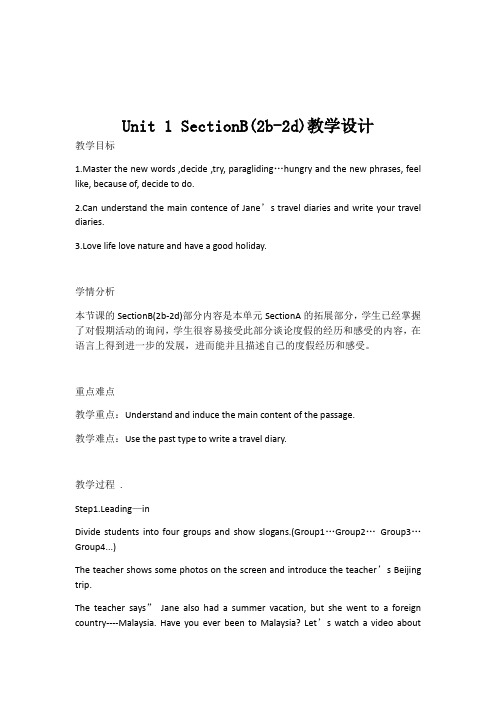
Unit 1 SectionB(2b-2d)教学设计教学目标1.Master the new words ,decide ,try, paragliding…hungry and the new phrases, feel like, because of, decide to do.2.Can understand the main contence of Jane’s travel diaries and write your travel diaries.3.Love life love nature and have a good holiday.学情分析本节课的SectionB(2b-2d)部分内容是本单元SectionA的拓展部分,学生已经掌握了对假期活动的询问,学生很容易接受此部分谈论度假的经历和感受的内容,在语言上得到进一步的发展,进而能并且描述自己的度假经历和感受。
重点难点教学重点:Understand and induce the main content of the passage.教学难点:Use the past type to write a travel diary.教学过程.Step1.Leading—inDivide students into four groups and show slogans.(Group1…Group2…Group3…Group4...)The teacher shows some photos on the screen and introduce the teacher’s Beijing trip.The teacher says”Jane also had a summer vacation, but she went to a foreign country----Malaysia. Have you ever been to Malaysia? Let’s watch a video aboutMalaysia.(播放关于介绍马来西亚的视频)StepⅡ.SkimStudents read the diaries and answer the two question.(Give them 1 minutes)⑴Did Jane have a good time on Monday?⑵What about on Tuesday?(学生进行抢答,答对的小组将获得一个苹果贴)StepⅢ.Intensive Reading.1. Students read the diaries again.(2minutes)⑴Find out the new words and deal with them in groups.(group work)First learn the new words, then write the new words on the paper ,next find Ss come to the blackboard to show what you have learnt.(到前面展示并领读的同学奖励一个苹果贴)⑵Find out the new phrases and deal with them in groups.(group work)First learn the new phrases, then write the new phrases on the paper ,next find Ss come to the blackboard to show what you have learnt.(到前面展示并领读的同学奖励一个苹果贴)2.Explain the important phrases.decide to dofeel likebecause of(能根据例句,总结出用法的同学,可获得一个小苹果)StepⅣ. Intensive Reading.Read Jane’s diary entries about her vacation and answer the following questions in groups. (Give them3 minutes)⑴Where did Jane go on vacation ?⑵Who did Jane go with ?⑶What was the weather like on Monday?⑷Did they go paragliding on the beach?⑸What did they eat on Tuesday?Students write the answers on the paper. (抢答,答对的小组获得一个苹果贴)StepⅤListening⑴Ss read the form contents quickly.⑵The teacher play the record, Ss listen to the tape and fill in the chart.⑶Check the answers.(抢答,答对的小组获得一个苹果贴)⑷Introduce Penang Hill.(展示关于滨城山的景色图片,让学生了解槟城山的景色,提高学生的学习情趣)StepⅥRole—play the conversation.⑴Read the conversation then fill in the chart..⑵Find a student to write down the answers on the white board.. (答对的同学,小组获得一个苹果贴)⑶Work in pair. Make the conversation ,but this time there aren’t answers on the white board.(到前面表演对话的同学可获得一个苹果贴)StepⅦWritingI think you must have your exciting vacation, Write your travel diary like Jane’s on page5.You can use following information.1.Where did you go?5.What food did you eat?2.Did you go with anyone?6.What did you like best?3.How was the weather?7.How did you go there?4.What did you do ?8.How did you feel about the trip?⑴Ss write down their travel diaries.⑵Let Ss to show their travel diaries.(教师让学生到白板前用展台展示自己的旅行日记,并讲解日记的格式,时态,帮助学生改正日记的错误之处。
新人教版初中英语八年级上册教案 Unit1-Unit10 全册

Unit 1Where did you go on vacation?第1课时Section A(1a ~ 2d)教学步骤自主学习案1.学生自学新单词和词组(教材P1的单词),看谁记得又快又准。
(1 分钟)【新词自查】2.根据首字母及汉语提示完成句子。
(3分钟)(1) He told her not to tell a nyone.(2)There had never been such a beautiful woman a nywhere in the world.(3) This world is a w onderful place.(4)Only a f ew people here know his name.(5)On Sunday, I like staying at home m ost of the time to watch TV.(6)Quite a few(相当多)students were late this morning.课堂导学案Step 1情景导入参考案例T:What did you do last Sunday?S:…T:Today we are going to learn how to talk about past events.环节说明:从询问全班学生的度假情况入手,让学生初步理解对过去事情的谈论,以及其基本结构。
激发学生学习本单元的兴趣,自然地导入新课。
Step 2完成教材1a~1c的任务1.要求学生翻开课本P1,理解1a中单词或短语的意思,并按要求完成课本上相应的任务。
(1分钟)T:What can you see?Each picture shows something a person did in the past.Now, please match each phrase with one of the pictures.2.检查答案,先要求几名同学给出他们的不同答案,并全班一起讨论。
初中英语_初中英语八年级上Unit1教学设计学情分析教材分析课后反思
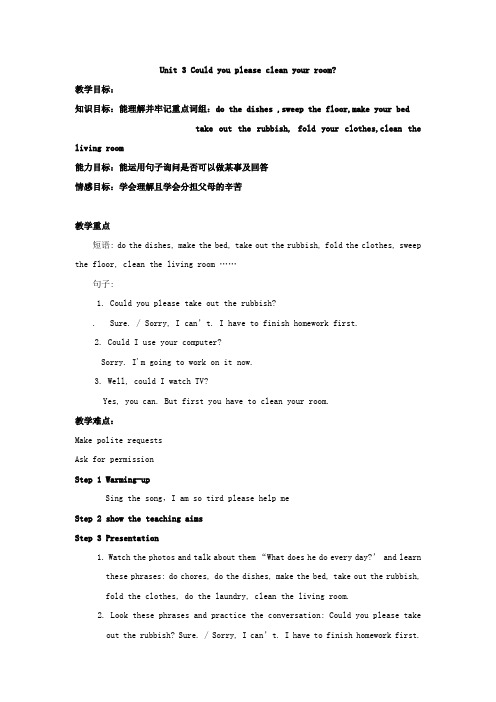
Unit 3 Could you please clean your room?教学目标:知识目标:能理解并牢记重点词组:do the dishes ,sweep the floor,make your bedtake out the rubbish, fold your clothes,clean the living room能力目标:能运用句子询问是否可以做某事及回答情感目标:学会理解且学会分担父母的辛苦教学重点短语: do the dishes, make the bed, take out the rubbish, fold the clothes, sweep the floor, clean the living room ……句子:1. Could you please take out the rubbish?. Sure. / Sorry, I can’t. I have to finish homework first.2. Could I use your computer?Sorry. I'm going to work on it now.3. Well, could I watch TV?Yes, you can. But first you have to clean your room.教学难点:Make polite requestsAsk for permissionStep 1 Warming-upSing the song,I am so tird please help meStep 2 show the teaching aimsStep 3 Presentation1. Watch the photos and talk about them “W hat does he do every day?’ and learnthese phrases: do chores, do the dishes, make the bed, take out the rubbish, fold the clothes, do the laundry, clean the living room.2. Look these phrases and practice the conversation: Could you please takeout the rubbish? Sure. / Sorry, I can’t. I have to finish homework first.3. 1a Do you do these chores at home? Discuss them with your partner.Step 4 Listening1b Listen. Who will do these chores? Check (√) Peter’s mother or Peter.Step 5 Practice1c Make conversations about the chores in 1a.Make conversations.ExamplesA: Could you please...?B: Yes, sure. /All right. /No problem./Certainly.Sorry, I can't. I have to do...Sorry, I can't. I am doing...Step 6 Listening 2a&2bPeter asks his father if he can do four things. What does his father say? Check (√) “yes” or “no”. Listen again. Draw lines to the reasons.Step 7 Practice2c Make conversations using the information in 2a and 2bA: Could I use your computer?B: Sorry. I’m going to work on it now.A: Well, could I watch TV?B: Yes, you can. But first you have to clean your room?2d Role –play the conversationStep 8 Summary1. New vocabularydo the dishes, sweep the floor, take out the trash, make the bed, fold the clothes, clean the room2. ---Could you please…?---Yes, please. / Sorry, I can’t.Step 9 exercise用下列词的适当形式填空Complete the sentences:1.A: What are you going to do today?B: ___________(去购物).2. A: I think you should help me more with the chores.B: Sorry I can’t. I _________(我得洗盘子).3.A: Could you please help her wash her car now?B: Sorry, I can’t .I am busy. _______(我得洗衣服)4. A: Is Helen busy?B: Yes. __________(她得去扫地).5. A:___________(我能看一下你的票吗)?B: Of course. Here you are.Step 10 情感教育Watch a movieStep 11 Homework1 List all the main phrases of doing chores that you know. (必做)2 Make a conversation between you and your mother, using the sentence pattern “Could you please …?” (选做)本课话题来自学生的生活经历,学生在初一时期已经学习了许多动词短语,为表达提供了语言基础。
人教版初中英语2011课标版 八年级上册第一单元Section B 2a —2e阅读教学设计

Unit1 Where did you go on vacation?(Section B 2a-2e)教学设计一、教材分析本篇阅读材料讲述了一名学生Jane和家人在马来西亚度假期间的见闻和趣事。
语篇内容包括了对马来西亚的槟城山和著名海乾街的介绍。
本节课旨在通过寻读、略读和看图预测等方法掌握阅读信息,完成阅读任务,提高学生获取信息、分析问题、解决问题的综合语言运用的能力。
同时学生通过阅读了解马来西亚的风土人情,在阅读中获得中西方文化的差异,培养学生跨交际意识的能力,引导学生能够学会快乐有意义地享受假期生活。
二、学情分析优势:八年级的学生已经具备一定的英语阅读素养,能够对阅读材料进行基本的归纳、分析、表述。
劣势:初中生仍是以形象思维为主,对阅读的认识仍处于感性阶段,综合分析能力不强,自主学习能力差。
三、学习目标(一)知识目标1.New words:try,bird,bicycle,building,trader,wonder,difference,top,wait,umbr ella,wet,below,enough,hungry,as,decide to do sth,feel like,because of2.Useful expressions1)My sister and I tried paragliding.2)I felt like I was a bird.3)What a difference a day makes!4)And because of the bad weather, we couldn’t see anything below. 5)I wonder what life was like here in the past.(二)技能目标1.通过略读需要关注每段的首尾句并找出每段的关键词、短语或句子。
2.通过精读搜查细节信息以who,when,where,what,how五方面理解文章。
人教版初中英语八年级上册unit1《What’s the matter》优质教案

Unit 1 What’s the matter?Section A (1a-1c)一、教学目标:1. 知识目标:1) 重点单词:cold,fever,throat,back,toothache,stomachache 2)重点词组:have a cold,have a fever,have a sore throat…3)重点句型:what’s the matter? 及其回答I have a cold / fever…2. 能力目标:1)能听懂谈论健康问题的对话材料;能根据别人的健康问题提建议;2) 能写出重点单词和重点句型,并能描述怎样对待健康问题。
3. 情感目标:通过开展扮演病人等活动,培养学生关心他人身体健康的品质。
通过本课的阅读,培养学生处理紧急事件的基本能力,树立紧急事件时互相帮助的精神。
二、教学重难点1. 教学重点:1) 掌握本部分出现的生词和词组,达到熟练运用的目标。
2) 掌握重点句型What’s the matter ?及其回答方式I have…2. 教学难点:1) 由have a cold,have a sore throat,have a toothache总结出have a +病症, have a sore +发病部位,have a +部位-ache的规律。
2) 重点句型What’s the matter ?及其同义句What’s wrong?的区别。
三、教学过程Step1 Lead-in播放视频《来自星星的你》片段,导入新课,板书课题。
Step2 Show the aims1. Master some useful phrases.2. Make conversations.3. Train listening.Step3 Task 1 (2’)Look at the picture and finish 1a .Step4 Task 2(5’)Learn some phrases.a. Translate the following phrases.b. Read and write them.c. Show and check.d. Find some rules.1.感冒have a cold2.发烧have a fever3.喉咙痛have a sore throat4.背痛have a sore back5.牙痛have a toothache6.胃痛have a stomachacheRules:have a + 病症have a sore +发病部位have a +部位-acheStep5 Task 3 (15’)Make conversations播放一个小女孩假装生病的幽默短片,引出句型:What’s the matte r?a. Ask some students read conversations, others follow.b. Two students in a group, practice the converstation.c. Play a snowball game to practice the conversation.d. Pair work. Use different persons to practice conversations.Pair work:A: What’s the matter?B: I …...A: What’s the matter with her/him?B: She / He …...Step6 Task 4 (3’ )Listen to the tape and finish 1b.Step7 Exercise一.用所给词的适当形式填空。
人教版八年级英语上册第一单元教案

人教版八年级英语上册第一单元教案教学目标- 通过本单元的研究,学生能够掌握以下知识点:- 学会介绍自己的姓名、年龄和家庭成员;- 学会用英语进行日常问候和告别;- 掌握一些日常用语,如感谢、对不起等;- 学会用英语进行简单的自我介绍。
教学重点- 学会用英语进行日常问候和告别;- 学会介绍自己的姓名、年龄和家庭成员。
教学准备- 教学课件;- 学生教材及练册;- 彩色粘纸;- 彩色笔。
教学过程导入新课1. 利用图片或课件引导学生对英语问候和告别进行讨论,激发学生的兴趣。
研究新知2. 分小组让学生彼此进行问候和告别的练,引导正确的语音和语调。
新知讲解3. 通过课件或黑板,向学生介绍并教授以下句型:- What's your name? My name is [name].- How old are you? I'm [age] years old.- Who's this? This is my [family member].合作练4. 学生分组进行角色扮演练,模拟真实生活中的日常对话,并互相评价。
拓展延伸5. 让学生用英语进行简单的自我介绍,以加强他们的口语表达能力。
巩固练6. 学生根据教材中的练完成相关练题,巩固所学内容。
作业布置7. 布置学生的课后作业,包括完成学生教材的练和准备下节课的内容。
教学反思本节课通过多样化的教学方法,如导入新课、学习新知、合作练习等,让学生在积极参与中学习和巩固了英语问候和介绍自己的知识点。
同时,通过角色扮演和互相评价,培养了学生的口语表达能力和团队合作意识。
我将继续关注学生的学习情况,及时调整教学策略,使他们对英语学习更加感兴趣和自信。
初中英语人教版八年级上册Unit1SectionB(2b—2d)教学设计

1.学生跟随教师阅读2b部分的对话,了解Cappy的基本情况。
2.教师讲解并板书重点词汇和句型,如"talented robot", "perform tasks", "control by smartphone"等,让学生跟读并模仿。
3.学生分组进行角色扮演,练习对话中的句型,加深对词汇和句型的理解。
(一)导入新课
1.教师通过多媒体展示一组机器人的图片,包括Cappy的图片,引导学生观察并思考:What do you know about robots? What can they do?
2.学生分享自己对机器人的了解和看法,教师总结并板书关键词。
3.教师提出问题:Do you want to know more about Cappy, a talented robot?引出本节课的主题——学习Unit 1 Section B 2b-2d的内容,了解机器人Cappy的特点和功能。
-不少于80词,要求语言通顺,表达清晰。
2.阅读一篇关于机器人的英文文章,并完成相关阅读理解练习。要求:
-运用课堂所学的阅读策略,提高阅读速度和理解能力。
-关注文章中的细节,捕捉关键信息。
-完成阅读理解练习,检验自己的阅读效果。
3.小组合作,制作一份关于机器人的英文手抄报。要求:
-选择一个主题,如“机器人的发展历程”、“机器人在生活中的应用”等。
初中英语人教版八年级上册Unit1SectionB(2b—2d)教学设计
一、教学目标
(一)知识与技能
1.学生能够理解并掌握本章节所学的词汇和句型,如"robot", "ability", "control", "talent", "perform"等,并能正确运用到日常生活交流中。
初中英语人教版八年级上册Unit1教学设计
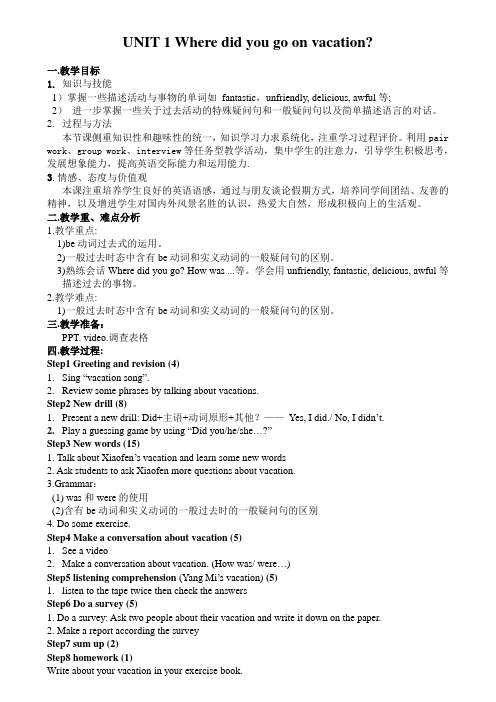
UNIT 1 Where did you go on vacation?一.教学目标1.知识与技能1)掌握一些描述活动与事物的单词如fantastic,unfriendly, delicious, awful等;2)进一步掌握一些关于过去活动的特殊疑问句和一般疑问句以及简单描述语言的对话。
2.过程与方法本节课侧重知识性和趣味性的统一,知识学习力求系统化,注重学习过程评价。
利用pair work、group work、interview等任务型教学活动,集中学生的注意力,引导学生积极思考,发展想象能力,提高英语交际能力和运用能力.3.情感、态度与价值观本课注重培养学生良好的英语语感,通过与朋友谈论假期方式,培养同学间团结、友善的精神,以及增进学生对国内外风景名胜的认识,热爱大自然,形成积极向上的生活观。
二.教学重、难点分析1.教学重点:1)be动词过去式的运用。
2)一般过去时态中含有be动词和实义动词的一般疑问句的区别。
3)熟练会话Where did you go? How was ...等。
学会用unfriendly, fantastic, delicious, awful等描述过去的事物。
2.教学难点:1)一般过去时态中含有be动词和实义动词的一般疑问句的区别。
三.教学准备:PPT. video.调查表格四.教学过程:Step1 Greeting and revision (4)1.Sing “vacation song”.2.Review some phrases by talking about vacations.Step2 New drill (8)1.Present a new drill: Did+主语+动词原形+其他?——Yes, I did./ No, I didn’t.2.Play a guessing game by using “Did you/he/she…?”Step3 New words (15)1. Talk about Xiaofen’s vacation and learn some new words2. Ask students to ask Xiaofen more questions about vacation.3.Grammar:(1) was和were的使用(2)含有be动词和实义动词的一般过去时的一般疑问句的区别4. Do some exercise.Step4 Make a conversation about vacation (5)1.See a video2.Make a conversation about vacation. (How was/ were…)Step5 listening comprehension (Yang Mi’s vacation) (5)1.listen to the tape twice then check the answersStep6Do a survey (5)1. Do a survey: Ask two people about their vacation and write it down on the paper.2. Make a report according the surveyStep7 sum up (2)Step8 homework (1)Write about your vacation in your exercise book.。
初中英语 人教版八年级上Unit 1 Section B( 1a-1e)教学设计
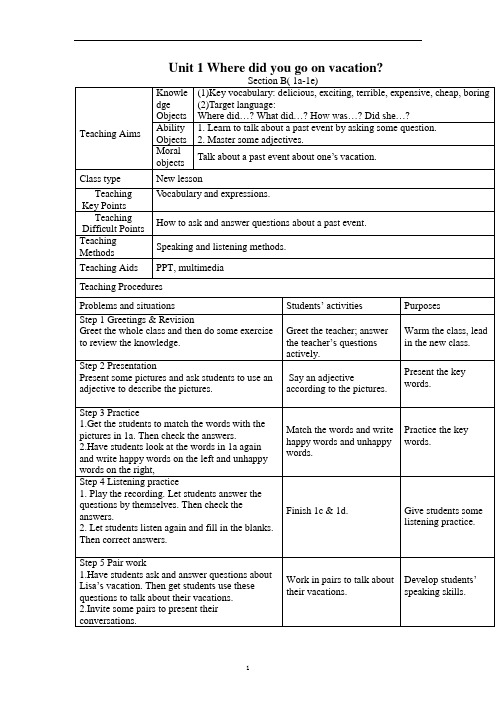
SectionB(1a-1e)
Teaching Aims
Knowledge Objects
(1)Key vocabulary: delicious, exciting, terrible, expensive, cheap, boring
Moral objects
Talk about a past event about one’s vacation.
Class type
New lesson
Teaching
Key Points
Vocabulary and expressions.
Teaching Difficult Points
How to ask and answer questions about a pastion
Present some pictures and ask students to use an adjective to describe the pictures.
Say an adjective according to the pictures.
Present the key words.
Match the words and write
happy words and unhappy words.
Practice the key words.
Step 4 Listeningpractice
1. Play the recording. Let students answer the questions by themselves.Then check the answers.
Step 3 Practice
Unit 1 Where did you go on vacation初中八年级上册英语教案教学设计
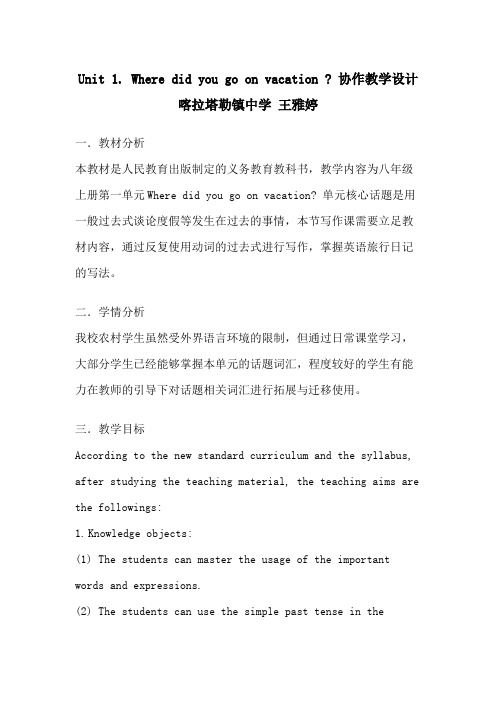
Unit 1. Where did you go on vacation ? 协作教学设计喀拉塔勒镇中学 王雅婷一.教材分析本教材是人民教育出版制定的义务教育教科书,教学内容为八年级上册第一单元Where did you go on vacation? 单元核心话题是用一般过去式谈论度假等发生在过去的事情,本节写作课需要立足教材内容,通过反复使用动词的过去式进行写作,掌握英语旅行日记的写法。
二.学情分析我校农村学生虽然受外界语言环境的限制,但通过日常课堂学习,大部分学生已经能够掌握本单元的话题词汇,程度较好的学生有能力在教师的引导下对话题相关词汇进行拓展与迁移使用。
三.教学目标According to the new standard curriculum and the syllabus, after studying the teaching material, the teaching aims are the followings:1.Knowledge objects:(1) The students can master the usage of the important words and expressions.(2) The students can use the simple past tense in theproper situation.(3) The students can understand the content of the lesson, talk about holidays and vacations and get their own ideas about how to keep an English diary about travelling.2.Ability objects:(1) To develop the students’ abilities of listening, speaking, reading and writing.(2) To guide students to set up effective studying strategies.(3) To improve the students’ writing ability.3.Emotion or moral objects:By completing the task, Students increase their interest in travelling and set up self-confidence in Chinese Culture.四.教学重难点Based on the requirement of syllabus.The important points is the usage of the simple past tense, such as the correct forms of the regular and irregular verbs.The difficult points are the English writing structures and skills, such as the logical order and the conjunctions.五.教学方法As is known to us all, a good teaching method requires that the teacher should help students develop good sense of the English language. For achieving these teaching aims,I will use the following methods according to the modern social communication teaching theories.(1) Communicative approach(2) Total Situational Action六.教学过程Step1. Lead inDiscuss the Pictures on RMB including the scenery spots and the exact places.100-The great hall of the people 50-the Po-tala Palace 20-Guilin Scenery10-Three Gorges 5-Mount Tai 1-Three Pools Mirroring the Moon设计意图:从学生所熟悉的实物入手,激发学生开口说英语的兴趣,引导学生说出旅游见到的基本元素及地理位置,再看中华山水与实际生活的完美结合,激发学生对祖国文化的自信,逐步进入主题。
初中八年级英语第一课教案

初中八年级英语第一课教案Objectives:1. To learn how to greet people and introduce oneself in English.2. To practice the use of present tense in describing one's age, nationality, and hobbies.3. To develop listening, speaking, reading, and writing skills.Materials:1. Textbook: English 8A2. Teacher's Manual3. Worksheets4. Flashcards5. Audio recording of the dialogueProcedure:1. Warm-up (5 minutes)a. Teacher asks students to write down three sentences about themselves (name, age, hobby).b. Students read their sentences to the class and introduce themselves.2. Introduction (10 minutes)a. Teacher introduces the new lesson topic: Greetings and Introductions.b. Teacher shows flashcards of different people and asks students to guess their names, ages, and nationalities.c. Students practice introducing themselves using the present tense (e.g., I am 14 years old, I am from China, I like playing soccer).3. Listening (15 minutes)a. Teacher plays the audio recording of the dialogue and asks students to listen carefully.b. Students answer the following questions:1. Who are the two speakers?2. Where are they from?3. How old are they?4. What are their hobbies?4. Speaking (10 minutes)a. Students role-play the dialogue in pairs, using the present tense to introduce themselves.b. Teacher asks volunteers to perform their role-plays in front of the class.5. Reading (10 minutes)a. Teacher hands out the worksheets and asks students to read the passage about greetings and introductions.b. Students complete the exercises on the worksheet, including fill-in-the-blanks, true/false, and matching.6. Writing (10 minutes)a. Teacher asks students to write a short paragraph about themselves, including their name, age, nationality, and hobbies.b. Students share their paragraphs with the class and read them aloud.7. Summary (5 minutes)a. Teacher reviews the main points of the lesson, including how to greet people and introduce oneself in English.b. Students ask any questions they have.8. Homework (5 minutes)a. Teacher hands out the homework assignment, which includes practicing the dialogue, completing additional exercises, and preparing for the next lesson.b. Students take the assignment home and complete it for homework.Note: This lesson plan can be adjusted according to the level and needs of the students.。
20242025学年度第一学期秋学期人教版初中英语八年级上册教学计划附教学进度表
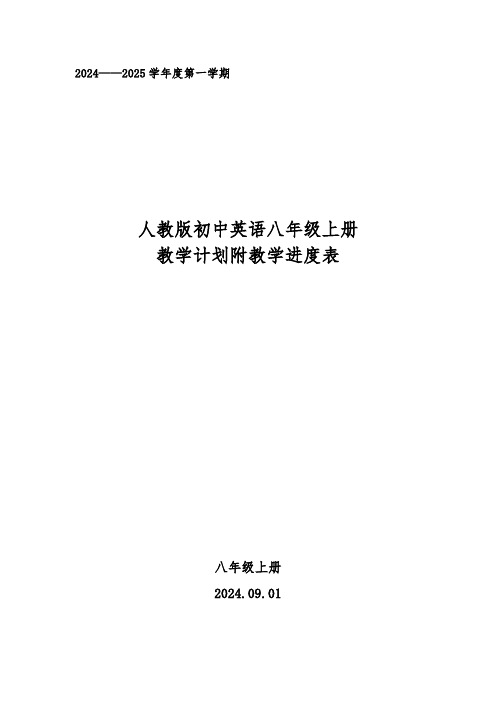
2024——2025学年度第一学期人教版初中英语八年级上册教学计划附教学进度表八年级上册2024.09.012024年秋学期人教版初中英语八年级上册教学计划附教学进度表一、学情分析本学期由我担任八年级(1)班英语学科教学工作。
大部分学生已养成良好的英语学习习惯,掌握了科学的英语学习方法,但是主观能动性不足,探究能力及英语鉴赏能力水平不高。
在本学期的教育教学工作中发挥学生的主观能动性,重点培养他们的探究能力及英语鉴赏能力。
二、教学内容与教材分析本册教材包括:Unit1 Where did you go on vacation? Unit2 How often do you exercise? Unit3 I'm more outgoing than my sister. Unit4 What's the best movie theater? Unit5 Do you want to watch a game show? Unit6 I'm going to study computer science. Unit7 Will people have robots? Unit8 How do you make a banana milk shake? Unit9 Can you come to my party? Unit10 If you go to the party,you'll have a great time,共10个单元。
Unit1 Where did you go on vacation?本单元通过功能语言交流假期去了什么地方旅行,学习掌握相关词汇和复合不定代词someone, anyone, something, anything等的用法及yourself, myself等反身代词的用法。
培养语言表达能力。
Unit2 How often do you exercise?本通过相互的调查与讨论,得出什么样的英语学习习惯才是最好的、什么样的生活习惯才是最健康的这个话题。
初中英语人教版八年级上册Unit 1Section B 教学设计
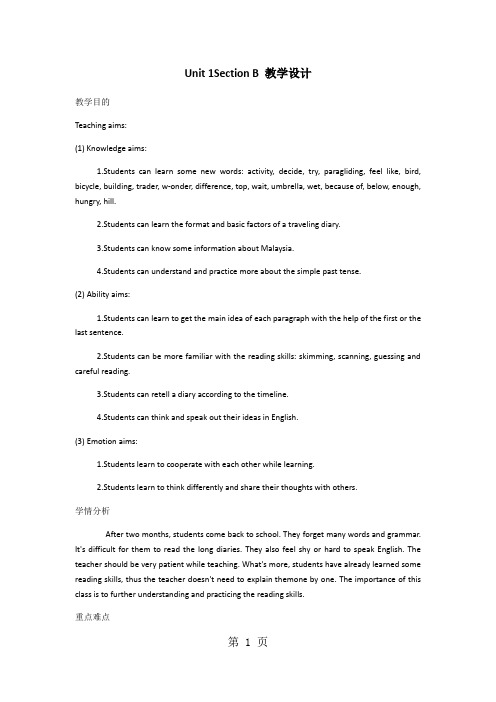
Unit 1Section B 教学设计教学目的Teaching aims:(1) Knowledge aims:1.Students can learn some new words: activity, decide, try, paragliding, feel like, bird, bicycle, building, trader, w-onder, difference, top, wait, umbrella, wet, because of, below, enough, hungry, hill.2.Students can learn the format and basic factors of a traveling diary.3.Students can know some information about Malaysia.4.Students can understand and practice more about the simple past tense.(2) Ability aims:1.Students can learn to get the main idea of each paragraph with the help of the first or the last sentence.2.Students can be more familiar with the reading skills: skimming, scanning, guessing and careful reading.3.Students can retell a diary according to the timeline.4.Students can think and speak out their ideas in English.(3) Emotion aims:1.Students learn to cooperate with each other while learning.2.Students learn to think differently and share their thoughts with others.学情分析After two months, students come back to school. They forget many words and grammar. It's difficult for them to read the long diaries. They also feel shy or hard to speak English. The teacher should be very patient while teaching. What's more, students have already learned some reading skills, thus the teacher doesn't need to explain themone by one. The importance of this class is to further understanding and practicing the reading skills.重点难点Important points:1.Students understand the basic factors of a traveling diary.2.Students try to use the reading skills: skimming, scanning, guessing and careful reading.Difficult points:1.The improvement of students’reading skills.2.Students try to think differently and speak out their own ideas in English.3.Students understand and remember the basic factors of a travel diary.教学过程.【讲授】教学过程Teaching process:Stage 1. Get students ready for learning.Step 1. Greet as usual.(Class begins! Good morning, class! Sit down, please!)Step 2. Free talk about the teacher’s traveling photo in Malaysia.(After two months, you come back to our school. How about your vacation? Did you have a good time? Where did you go? Do you want to know my vacation? Look at the photo. Which one is me? Can you guess? Where did I take this photo? In Chongqing? No. Well, let me tell you.)Stage 2. Pre-reading:Step 1. Lead-in with a map of Malaysia.(Look at the map. What country here? Yes, China, our country. In July, I took an airplane to this place. Can you guess what country there? Yes, Malaysia.)Step 2. Share some photos of the teacher’s traveling in Malaysia. Review new words.(Where did I go in Malaysia? Do you want to know? Ok, I took many interesting photos. I’d like to share the photos with you. [Give a piece of paper to each group. Ask students to share the photos with each other.] Discuss two questions: Where did I go in Malaysia? Whatdid I do?)Stage 3. While-reading:Task 1. Scan the first three lines of the first diary. Circle where, when, who and weather.(Do you think my vacation is exciting? Do you want to know more about Malaysia? Ok, let’s open the English book and turn to P5. Today we’re going to learn Unit1, section B 2b. Look at the first diary. Please scan the first three lines and circle. where did the writer go? When did the writer go there? Who is the writer? Who did the writer go with? How about the weather? Ready? Go!)Task 2. Skim and find key words or sentences in the first diary.(Now we know Jane went to Penang on Monday. So how about her vacation? Did Jane have a good time on Monday? Skim and find the key words or sentences in the first diary.)Task 3. Careful reading: Finish the timeline and retell the diary according to it in groups.(Jane had a good time on Monday. Why? What did she do? Let’s go to careful reading. Now read lines2-6. Answer three questions. Now we’re clear about Jane’s vacation on Monday morning. How about her lunch time and afternoon? Let’s read the rest of the diary and finish the timeline. Then retell Jane’s vacation by the timeline in groups. Give an example.)Task 4. Scan the first three lines of the second diary. Circle where, when, who and weather.(Now we’re clear about Jane’s vacation on Monday. How about her next day? Let’s go into the second diary. Scan the first three lines and circle where, when, who and the weather.)Task 5. Skim and find key words or sentences in the second diary.(We know Jane went to Penang Hill with her father. How about their vacation? Did Jane have a good time on Tuesday? Skim the diary and try to find the key words or sentences.)Task 6. Try to guess a new word by word-building.(Please look at the first sentence. Here is a new word for you “difference〞. We don’t know this word, but we learned this word “different〞. Can you guess the meaning of the new word by “different〞? This way is word-building. You can guess a new word by word-building. From the first sentence we can know the two days are different. So this is a key sentence.)Task 7. Try to guess new words by context.(Look at the end of the diary. Here are another two new words for you. Can you guess the meanings by the context?)Stage 4. Post-reading:Task 1. Read again and match the results with the reasons. Then lead to the topic.(Jane was unhappy on Tuesday. Why? Now let’s read again and match the results with the reasons.)Task 2. Discuss in groups about the topic. Encourage students to think differently.Then share thoughts.(Have a think: Did Jane like the weather? Did Jane like the train? Did Jane like the food? Why? Discuss with group members. Speak out your ideas. Give an example. The teacher asks: Did Jane like the food? [Students have different answers.] Maybe yes. Maybe no. Well, no answer is always right. Try to think differently. You can discuss after class.)Stage 5. Summary:Today we read Jane’s diary. It’s a travel diary. When we read a travel diary, we should find this information: where, when, who, what, how. We also learned some reading skills: scanning, skimming, careful reading and guessing. (Write on the blackboard) Try to use the reading skills, then you can read better and better.1.Learn the format and basic factors of a traveling diary.2.Learn to use reading skills: skimming, scanning, guessing and careful reading.3.Further learning about the simple past tense.Stage 6. Homework:Imagine Jane went to Penang Hill again and had a great day. Fill in the blanks with the right forms of the verbs in 2e. Then make reading notes about the day.Students finish the assessment-and-feedback chart about learning in the class. Then hand it in to the teacher after class.Stage 7. Enjoy beautiful sentences about traveling:Everyone has only one life. There must be something you have never seen and somewhere you have never been. Just go for it! Write them in your diary.Stage 8. Class is over.Blackboard design:Unit 1 Where did you go on vacation? 2bWhere SkimmingWhen ScanningA traveling diary: Who Reading skills:Careful readingWhat GuessingHow (by word-building&context)Tense: simple past tense【作业】英语阅读课形成性评价反响表〔灵敏处理,课堂或课后完成〕英语阅读课形成性评价反响表(the assessment-and-feedback chart)课题:Where did you go on vacation? Section B 2b以下是本节课学习的主要内容,请各小组同学根据实际学习情况在表中填写番号:1、分享关于Malaysia的照片2、用照片中的单词答复下列问题3、第一篇日记的扫读训练4、第一篇日记的略读训练5、细读填写时间轴6、用时间轴进展复述7、第二篇日记的扫读训练8、第二篇日记的略读训练9、因果连线10、话题讨论11、阅读中单词学习12、对教师的英语指令的反响13、对教师的英语提问或讲解的反响小组成员姓名:学习过程中感兴趣的局部:学习过程中感觉容易的局部:学习过程中感觉困难的局部:学习中积极考虑、主动探究自评:小组活动参与积极性自评:给教师或小组同伴的建议:。
聚焦语言实践与运用培养英语口语交际能力——以人教版《英语》八年级上册Unit1为例

1222018年23期总第411期ENGLISH ON CAMPUS聚焦语言实践与运用 培养英语口语交际能力——以人教版《英语》八年级上册Unit1为例文/程燕军《义务教育英语课程标准(2011年版)》指出,现代外语教育注重语言学习的过程,强调语言学习的实践性,主张学生在语境中接触、体验和理解真实语言,并在此基础上学习和运用语言。
我国义务教育阶段学生的英语学习以课堂为主阵地,语言实践活动主要靠教师组织,学生参与,语言环境很受限制,这就需要我们英语教师在组织课堂活动时要多花心思,通过创设真实或者几近真实的语言环境,最大限度地为学生提供良好的语言实践与运用的机会,使学生的英语交际能力得到较好培养。
一、构建基于学生生活实际的教学环境,通过生活化的语言实践活动培养英语交际能力《课标》要求英语教师要善于创设接近实际生活的各种语境,语言活动的内容和形式要贴近学生的生话实际,符合学生的认知水平和生活经验,语言活动要尽可能接近现实生活中语言使用的实际情况,使学生能够理解和掌握目标语言项目的真实意义和用法。
构建基于学生生活实际的教学环境,要求教师要善于将教材紧密联系学生的实际生活,通过营造“真实的”“生活化”的言语环境,把生活要素“引入”课堂,实现课堂内与课堂外的沟通,变课堂为言语交际的场景和处所,将教材变成具有时代气息的语言材料,让学生对源于生活的任务设计有一种亲切感,从而提高学生参与语言实践活动的兴趣和动机。
以教学人教版《英语》八年级上册Unit1 Where did you goon vacation?为例,本单元的语言教学目标要求学生掌握一般过去时的用法,课本里设计了多种生活情境,旨在让学生通过师生、生生的之间的语言活动达成教学目标。
但纵观全单元,话题多为虚构,介绍的活动与学生的生活实际相距较远,谈及的地方名貌似熟悉,却又显得有点陌生。
为了创设更为贴近生活的、更为真实的语言情境,授课老师结合教学内容对3b进行了调整,要求同学们互相走访进行问卷调查,然后,作调查情况汇报,汇报的时候必须向大家呈现被访问者预先准备好的外出活动照片,使语言活动有图有真相,老师把学生的生活照片投影到屏幕上,照片中景色与人物交融,情境逼真,深深地吸引了学生的注意力,激发了学生参与语言活动的兴趣和参与交际的欲望。
人教版初中英语课标版八年级上册第一单元SectionA1a2d教学设计
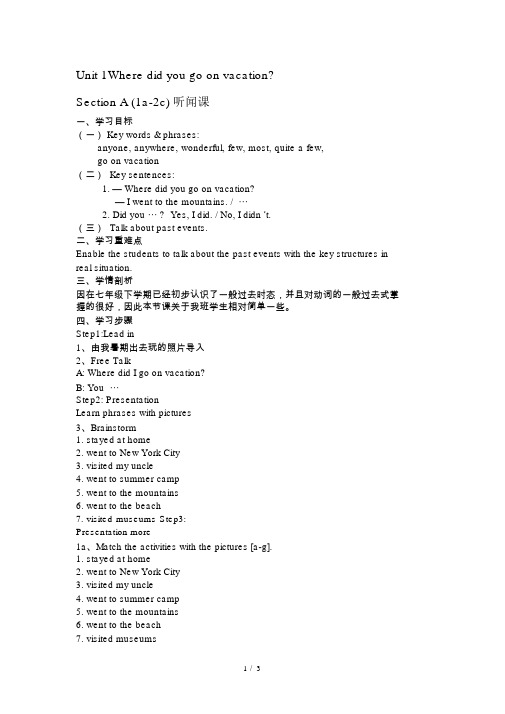
Unit 1Where did you go on vacation?Section A (1a-2c) 听闻课一、学习目标(一) Key words & phrases:anyone, anywhere, wonderful, few, most, quite a few,go on vacation(二) Key sentences:1.— Where did you go on vacation?— I went to the mountains. / ⋯2.Did you ⋯ ? Yes, I did. / No, I didn ’t.(三) Talk about past events.二、学习重难点Enable the students to talk about the past events with the key structures in real situation.三、学情剖析因在七年级下学期已经初步认识了一般过去时态,并且对动词的一般过去式掌握的很好,因此本节课关于我班学生相对简单一些。
四、学习步骤Step1:Lead in1、由我暑期出去玩的照片导入2、Free TalkA:Where did I go on vacation?B:You ⋯Step2: PresentationLearn phrases with pictures3、Brainstorm1.stayed at home2.went to New York City3.visited my uncle4.went to summer camp5.went to the mountains6.went to the beach7.visited museums Step3:Presentation more1a、Match the activities with the pictures [a-g].1.stayed at home _____2.went to New York City ______3.visited my uncle ____4.went to summer camp _____5.went to the mountains _____6.went to the beach ______7.visited museums ______Step4: PracticePairworkA:What did you\Miss Niu\... go on vacation?B:I\She went to the mountains.Step5: Consolidation1、Listen. Where did the people go on vacation? Complete the chart.2、Listen again. Check ( ? ) Yes, I did or No, I didn ’tfor each question.3、Listen for the third time. Complete the conversations with words\phrases orsentences.conversation1A:Where did you go on vacation ,Grace?B:I went to New York City.A:Oh, really? Did you go with anyone?B:Yes, I _____with my mother.A:Did you go to Central Park?B:Yes, I did . It was really nice.A: Did you buy _________?B: Yes, I bought something for my father.A: Oh, really? What?B: __ __ _____conversation2A:Where did you go on vacation ,Kevin?B:I went to the beach.A:Oh, that ’s nice !B:No, I didn ’t.A:Well , __ ___ ____?B:Yes, I did . The water was really warm.A:__ __ __ ___B:Everything_________ really good.A:Did you meet anyone interesting?B:Yes. I_________ some very interesting people.conversation3A:Where did you go on vacation ,Julie?B: I _________ at home.A:Oh, Did you do anything interesting?B:No, I didn ’t.A: Did you__ __ _____?B: Yes, I did.A:Did you go out with anyone ?B:No. No one was here. __ ___ __ __Step6: Practice students ’pronStep:7:Group workRole –play the conversations1、4 or 6 students in one group2、Play the conversations in real situation3、Practice for 4-6 mins4、Show us in the front of the classStep8: Summary— Where did you/they/he/she go on vacation ?— I/They/He/She went to the mountains/New York City/summer camp/the beach. — Did you... ?— Yes,I did./No , I didn't.Step9: HomeworkWrite a short passage about your summer vacation with the sentences we have learnt today and before. If you didn ’tgo out on summer vacation, you can write your friend ’s or Miss Niu ’s vacation.。
- 1、下载文档前请自行甄别文档内容的完整性,平台不提供额外的编辑、内容补充、找答案等附加服务。
- 2、"仅部分预览"的文档,不可在线预览部分如存在完整性等问题,可反馈申请退款(可完整预览的文档不适用该条件!)。
- 3、如文档侵犯您的权益,请联系客服反馈,我们会尽快为您处理(人工客服工作时间:9:00-18:30)。
鼓励学生把讨论内容发给老师。
学生说出本节课自己的收获:学到了阅读技巧、思维方法。
教师话语
学生在老师引导下完成反思。
下课后有多名学生向老师确认电子邮箱,表示要给老师发电子邮件。
总体反思:
这节课达到预期目标,因为学生基础很好,设计也基本符合学生的思维水平。此一课例充分说明:在9年级阅读教学中开展思维活动、价值活动,非常受欢迎,而且完全可行。
2、从不同角度分析有益与无益
教学设备
教材,黑板,学生名单
教学时间
教学步骤
学习目的
教师行为
学生行为
学习资源
教学过程反思
课前
课前启动
确定学习目标
根据学生意愿,请学生写出自己的名字,并询问学生名字准确读音,这保证了教师在课程全程以姓名称呼学生,而不是you, you这种不礼貌方式。
引导学生选择学习目标,询问选择理由。
多名学生进行记录promotion一词。
学习方案活动3
学生不仅很好地回答了所有问题,而且使用了很多初中教材之外的词汇,语句基本没有语法错误
11分钟
讨论
就自己想法进行讨论
老师让学生投票表决,选择问题,4票选择问题1;6票选择问题2,3票选择问题3。
老师说明票数,然后让学生讨论问题2.
老师询问学生是否需要进行思考,然后讨论。
让学生看阅读文章标题,通过吃武汉鸭脖子的经历说明experience的重要性。
了解学习内容,在老师引导下思考:阅读与思考的关系。
说出experience
听老师讲解experience的重要性,说出hot, spicy等。
教师话语
学生不大明白阅读与思考的关系;
鸭脖子激发了学生的兴趣;学生还说出热干面、臭豆腐等,显然理解了经历的重要性。
学生的陈述非常好,不仅有选择,而且有非常好的理由,甚至是很崇高的理由。
选择法国的学生陈述时间比较长,教师没能充分考虑给其足够时间,导致其陈述不完整。
这说明仍然需要把握如何合理分配时间给优秀学生。
1分钟
小结
总结本课时所学内容
让学生小结本节课的收获。
老师启发:学到了国际交往的重要性、通过国际交往交朋友的意义。
Experiences课堂实录与教学反思
教学内容
《英语》(新标准)8B M2 U2课文
学习目标
语言知识与技能
1、现在完成时
2、阅读“总述—分述”结构的文章
文化意识、情感态度、学习策略
1、理解人员国际流动的特性、价值
2、理解国际交往的收获
3、强化国际交往的意愿
4、强化归纳的策略
心智发展与素养提升
1、发现价值
学生完成活动2,几乎所有学生对于具体信息都能快速完成,但对于段落主要观点几乎都有这样那样的困难。
部分学生在老师帮助下进一步思考,发现了段落主要观点
学习方案活动2
学生归纳段落大意能力显然还存在不足,必要的帮助起到了一定的作用。此一过程说明这种归纳段落大意的能力,可以通过提问,让学生思考,从而形成。
这一过程充分说明本班学生已经形成抽象思维能力。
7分钟
回答问题
进一步理解短文
让学生回答活动3的问题。
在听到学生说出career后,老师给出了promotion这个词及其汉语“升职”语义。
学生分别回答问题,一个学生没有准确回答问题4的原因,其他学生帮助后回答。
学生回答问题Is the moving good for Peter? Give your reasons.时,准确地分析出了原因,说出了It’s good for his career.等。
6名学生发言,分别表达愿意去法国、美国、韩国、英国、西非、日本,原因一次是:浪漫,美食,学法语;美国文化,用好莱坞技术拍中国电影;歌星;福尔摩斯;消灭埃博拉;漫画。
选择法国的学生说,他本来要说making friends的,是老师没给时间。
学习方案活动4
部分学生没有投票,可能是不愿参与这个话题。
这说明话题选择仍然需要充分考虑学生不同兴趣。
少数学生开始表现出卓越的语言能力。
8分分钟
阅读文章
阅读文章,回答问题
让学生先看活动要求,理解每一项要求,尤其是划读。
巡视。
发现学生基本完成阅读全文后,让学生回答问题。
请一个学生回答第一个问题。
请四个学生分别回答Mike在四个国家所做的事情。
理解每一项活动要求。
了解学生语言水平。
部分应老师要求写下自己的名字。
了解学习目标的内涵。
了解学生方案四页内容,尤其是课后学习内容。
从教师给定的学习目标中,选择至少3个适合自己的目标。
教师设定的学习目标
多数学生按照顺序123选择,部分选择124等。目标排列顺序应该更随机一些。
2分钟
导入
激活学习动力与动机
告诉学生:今天我们开展阅读,通过阅读进行思考,告诉学生思考的重要性。
学习方案活动1
学生在阅读中存在不能辨别事实与观点的问题,看来要求超过了学生现实水平,教师在巡视时加以指导,很快很多学生能够标注了,说明学生具有一定的基础。
第二个问题需要一定的综合能力,学生完成得非常好。教师原本计划进行必要列表,则完成没有进行。
对于学生想象内容,老师没有否定,而是让学生进一步发现。
16分钟
朗读问题。
阅读文章,看要求划线、画三角符号。
在老师指导下改进。
按老师要求回答问题。
一个学生回答流畅。
第一个学生打出visit interesting places, learning new languages。
第二、三、四个学生顺着第一个学生回答基本给出相同内容,最后一位学生增加了enjoy food(此项其实文章中没有,为学生自己想象内容)。
老师让愿意陈述自己选择的学生进行陈述。
对想学法语的学生,老师教了Françoise, bonjour. Merci三个单词;对于选择好莱坞的学生,询问其拍片内容;赞扬选择西非、抗击埃博拉的学生;并肯定了每一位学生。
告诉学生没有提到making friends,应该注意。
学生举手投票。
学生表示不需要思考,可以直接进行讨论,并开始争相发言。
获取信息
检查对文章的理解,分析文章结构
让学生完成活动2这个理解全文、获取基本信息,并归纳每一段落的主要观点。
巡视。
通过提问,帮助段落归纳有显著问题的学生思考,如询问for example是关于部分,还是整体;They have made friends all over the world.是否关于going back to the US?
